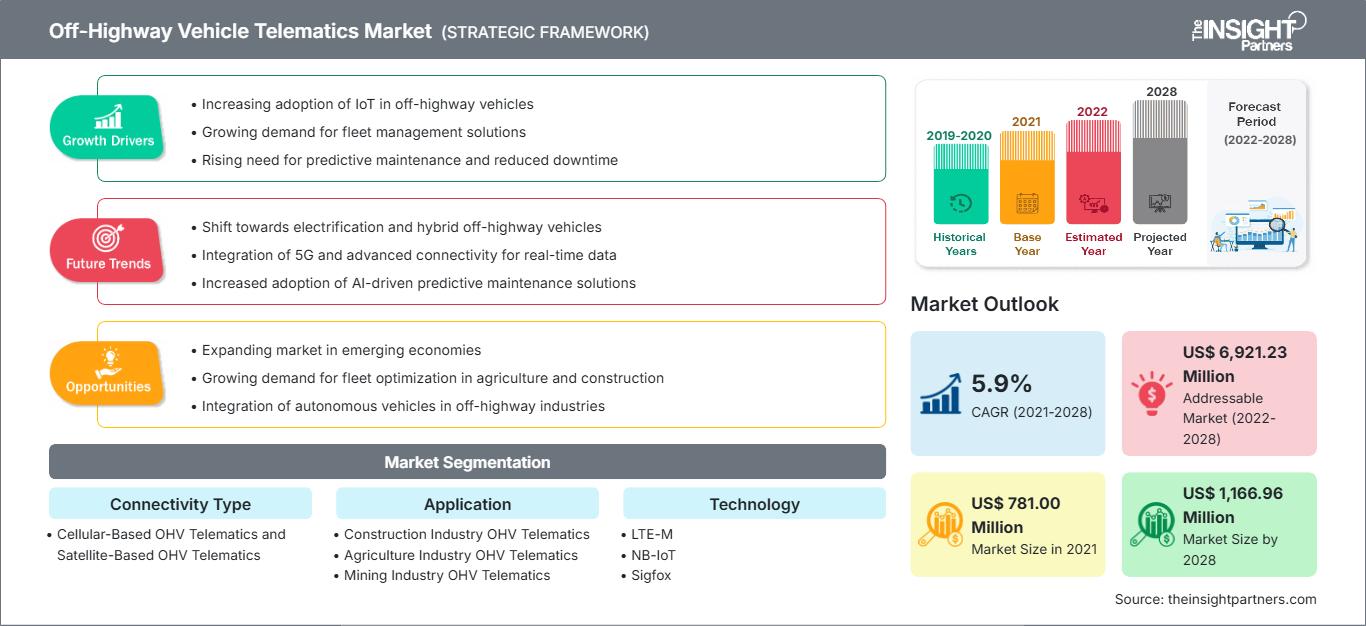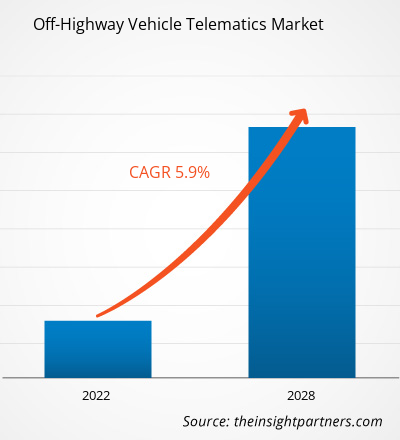오프로드 차량 텔레매틱스 시장은 2021년 7억 8,100만 달러 규모였으며, 2028년에는 11억 6,696만 달러에 이를 것으로 예상됩니다. 2021년부터 2028년까지 연평균 성장률(CAGR)은 5.9%에 이를 것으로 예상됩니다.
텔레매틱스 사업은 기술 발전으로 빠르게 발전해 왔습니다. 경쟁 우위를 확보하기 위해 반드시 살펴봐야 할 새로운 트렌드는 다음과 같습니다.
- 빠른 상호 연결 네트워크: 4G 및 5G 네트워크로의 업그레이드는 대역폭, 더 빠른 데이터 업로드 및 피드백 다운로드 측면에서 완전히 새로운 경험을 제공하여 더 많은 실시간 데이터 세트, 실시간 운전자 안전, 차량 유지 관리 및 차량 효율성을 제공합니다.
- 클라우드 활성화: 센서는 차량의 여러 하위 시스템에 연결됩니다. 이러한 시스템은 끊임없이 방대한 양의 데이터를 교환합니다. 타이어 공기압 모니터링, 비디오 캡처, 온도 모니터링 센서는 몇 가지 예에 불과합니다. 클라우드 기술의 발전으로 방대한 양의 데이터를 저장, 처리 및 효율적으로 사용할 수 있게 되었습니다.
- 소기업 도입: 텔레매틱스는 서비스 제공업체와 소규모 차량 소유주에게 단순한 트렌드가 아닙니다. 많은 스타트업이 소규모 차량 소유주를 위해 지역 시장에서 찾을 수 있는 저렴하면서도 효과적인 텔레매틱스 솔루션을 제공합니다.
- 직접적인 데이터 액세스 및 직관적인 대시보드: 사용자는 의사 결정을 위한 데이터에 직접 액세스할 수 있습니다. 개별 운전자, 배차 관리자, 중앙 차량 대행사 또는 지역 사무소, 그리고 프랜차이즈 가맹점 모두 이 데이터의 혜택을 누릴 수 있습니다. 모든 이해관계자는 제한된 접근 권한을 가진 개인화된 역할 기반 대시보드를 통해 특정 서비스 요구, 배송 또는 도착 시간, 처리 제약 조건 및 기타 요인을 기반으로 정보에 기반한 실시간 의사 결정을 내릴 수 있습니다. 이는 차량 관리 기업이 행동 기반 운전자 점수표를 유지하는 데 도움이 되며 법적 효력도 있습니다. 또한 많은 기업들이 도크 스케줄링 개선을 위해 해운 및 운송 업계와 데이터를 교환합니다. 이는 효과적인 계획 수립에 도움이 되고, 더욱 행복하고 생산적인 운전자가 될 수 있습니다.
따라서, 비도로 차량 텔레매틱스 분야의 기술 발전이 증가함에 따라 비도로 차량 텔레매틱스 시장이 성장할 것입니다.
요구 사항에 맞게 이 보고서를 사용자 정의하십시오.
이 보고서의 일부, 국가 수준 분석, Excel 데이터 팩을 포함하여 모든 보고서에 대한 사용자 정의를 무료로 받을 수 있을 뿐만 아니라 스타트업 및 대학을 위한 훌륭한 제안 및 할인을 이용할 수 있습니다
비도로 차량 텔레매틱스 시장: 전략적 통찰력

- 이 보고서의 주요 주요 시장 동향을 확인하세요.이 무료 샘플에는 시장 동향부터 추정 및 예측에 이르기까지 데이터 분석이 포함됩니다.
이 보고서의 일부, 국가 수준 분석, Excel 데이터 팩을 포함하여 모든 보고서에 대한 사용자 정의를 무료로 받을 수 있을 뿐만 아니라 스타트업 및 대학을 위한 훌륭한 제안 및 할인을 이용할 수 있습니다
비도로 차량 텔레매틱스 시장: 전략적 통찰력

- 이 보고서의 주요 주요 시장 동향을 확인하세요.이 무료 샘플에는 시장 동향부터 추정 및 예측에 이르기까지 데이터 분석이 포함됩니다.
건설 산업의 급속한 디지털 전환은 비도로 차량 텔레매틱스 시장에 새로운 전망을 제시하는 신기술 도입을 촉진하고 있습니다. 건설 장비 텔레매틱스는 기업이 장비의 위치와 성능을 추적하고, 자산 활용도를 모니터링하며, 자산이 효과적으로 사용되고 있는지 확인하는 데 도움을 줍니다. 장비 활용도가 낮을 경우 필요한 다른 위치로 이동할 수 있습니다. 이처럼 건설 장비 텔레매틱스는 전반적인 효율성을 향상시켜 비도로 텔레매틱스 시장에 긍정적인 영향을 미칠 것입니다.
또한, 민간 및 공공 부문 모두에서 건설 활동이 증가함에 따라 시장 성장이 촉진될 것으로 예상됩니다. 인도, 필리핀, UAE, 사우디아라비아, 이집트, 나이지리아, 미국 등의 국가에서 여러 인프라 관련 프로젝트가 진행 중이거나 계획되고 있습니다. 예를 들어, 인도 정부는 2014-2015 연방 예산의 '100개 스마트 도시' 프로그램의 일환으로 당해 회계연도에 11억 2천만 달러의 예산을 배정했습니다. 또한 정부는 향후 20년간 전국의 다양한 도시 및 인프라 프로젝트에 6,500억 달러를 투자할 계획이며, 이는 오프로드 차량 텔레매틱스 시장의 성장을 뒷받침할 것입니다. 중동에서는 제다 경제 도시(사우디 아라비아), 마스다르 시티(UAE), 두바이랜드(UAE) 등 다양한 인프라 프로젝트가 진행 중입니다. 이러한 인프라 프로젝트의 급속한 증가는 건설 장비 수요 증가로 이어질 것으로 예상됩니다.
COVID-19 팬데믹이 북미 오프로드 차량 텔레매틱스 시장에 미치는 영향
북미는 혁신을 촉진하고 인프라 역량을 강화하는 정부의 우호적인 정책 덕분에 신기술 개발 및 도입 측면에서 선도적인 지역 중 하나입니다. 따라서 산업 부문 성장에 대한 부정적인 영향은 이 지역의 경제 성장을 저해합니다. 현재 미국은 COVID-19 발생으로 인해 세계에서 가장 큰 피해를 입은 국가입니다. 자동차 회사 및 자동차 부품 제조업체와 같은 제조업체에 대한 비도로 차량 텔레매틱스 시장의 의존도는 COVID-19 발생으로 인한 최근 제조 시설의 중단으로 더욱 두드러졌습니다. COVID-19 발생 이전에도 자동차 산업은 전기 모빌리티, 자율주행차, 자동화된 공장, 승차 공유와 같은 어려움에 직면했습니다. 자동차 산업은 심각한 여행 제한, 국제 제조 중단, 자동차 판매 감소, 대규모 해고로 인해 큰 어려움을 겪고 있습니다. 산업이 정상적인 운영 상태로 돌아오면 비도로 차량 텔레매틱스에 대한 전반적인 수요가 증가할 것으로 예상됩니다. 자동차 수요 증가, 우호적인 정부 정책, 그리고 북미 국가들의 첨단 기술에 대한 투자 증가로 인해 북미는 비도로 차량 텔레매틱스에 대한 수요가 높습니다.
오프하이웨이 차량 텔레매틱스 시장 분석
IoT 통합 증가
초미세전자기계 시스템(MEMS), 인터넷, 무선 기술이 모두 결합되어 사물 인터넷(IoT)을 형성합니다. 차량 소유주는 IoT를 활용하여 차량 속도, 타이어 공기압, 연료 사용량, 운전자 행동을 원격으로 모니터링하여 차량 및 운전자의 효율성을 더욱 향상시킬 수 있습니다. 텔레매틱스 시스템 개발자는 이 기술을 사용하여 운영 비용이 높은 광업, 농업, 건설 산업의 특정 요구에 맞춘 텔레매틱스 솔루션을 개발할 수 있습니다. 서비스 제공업체와 차량 운영자는 IoT와 차량 관리 기술을 결합하여 예측 분석을 도입할 수 있습니다. 이를 통해 여러 주요 운영 영역에서 사전 예방적 관리와 경쟁 우위를 확보할 수 있습니다. 에어컨과 같은 서비스 지향 제품에 사용되는 IoT 센서는 정기적인 주기가 아닌 필요할 때만 서비스 콜을 알립니다. 상태 기반 모니터링은 서비스 비용을 절감하는 동시에 정확성과 고객 서비스를 향상시킵니다. 모든 차량에 가장 큰 비용 중 하나는 연료비입니다. IoT 센서가 텔레매틱스 시스템에 통합되면 차량 관리자는 차량 연료 사용량 및 지출을 거의 실시간으로 파악할 수 있습니다. 이를 통해 관리자는 효과적인 운전 습관 교육을 받아야 하는 사람을 파악하고, 연료 낭비를 유발하는 공회전과 같은 불법적인 운전 지출 및 운전 패턴을 추적할 수 있습니다. 또한, 모든 차량은 안전에 매우 중점을 두고 있습니다. 과속, 급제동, 난폭 운전 사고가 증가함에 따라, 차량 관리자는 운전자 코칭 및 안전 교육을 통해 바람직하지 않은 운전 행동을 개선할 수 있습니다. 따라서 IoT 통합 확대는 새로운 사업 가능성을 열어줄 수 있습니다.
연결 유형 기반 시장 분석
오프로드 차량 텔레매틱스 시장은 연결 유형에 따라 셀룰러 기반 OHV 텔레매틱스와 위성 기반 OHV 텔레매틱스로 구분됩니다. 셀룰러 기반 OHV 텔레매틱스 부문은 2020년 77.6%의 점유율로 비도로 차량 텔레매틱스 시장을 선도했습니다.
애플리케이션 기반 시장 분석
애플리케이션을 기준으로 비도로 차량 텔레매틱스 시장은 건설 산업 OHV 텔레매틱스, 농업 산업 OHV 텔레매틱스, 광업 OHV 텔레매틱스 등으로 세분화할 수 있습니다. 건설 산업 OHV 텔레매틱스 부문은 2020년 64.3%의 점유율로 비도로 차량 텔레매틱스 시장을 선도했습니다.
비도로 차량 텔레매틱스 시장
비도로 차량 텔레매틱스 시장
The Insight Partners의 분석가들은 예측 기간 동안 오프로드 차량 텔레매틱스 시장에 영향을 미치는 지역별 동향과 요인을 면밀히 분석했습니다. 이 섹션에서는 북미, 유럽, 아시아 태평양, 중동 및 아프리카, 그리고 중남미 지역의 오프로드 차량 텔레매틱스 시장 부문 및 지역별 현황도 살펴봅니다.
오프로드 차량 텔레매틱스 시장 보고서 범위
| 보고서 속성 | 세부 |
|---|---|
| 시장 규모 2021 | US$ 781.00 Million |
| 시장규모별 2028 | US$ 1,166.96 Million |
| 글로벌 CAGR (2021 - 2028) | 5.9% |
| 이전 데이터 | 2019-2020 |
| 예측 기간 | 2022-2028 |
| 다루는 세그먼트 |
By 연결 유형
|
| 포함된 지역 및 국가 | 북미
|
| 시장 선도 기업 및 주요 회사 프로필 |
|
오프로드 차량 텔레매틱스 시장 참여자 밀도: 비즈니스 역학에 미치는 영향 이해
오프로드 차량 텔레매틱스 시장은 소비자 선호도 변화, 기술 발전, 그리고 제품 이점에 대한 인식 제고 등의 요인으로 인한 최종 사용자 수요 증가에 힘입어 빠르게 성장하고 있습니다. 수요가 증가함에 따라 기업들은 제품 및 서비스 확장, 소비자 니즈 충족을 위한 혁신, 그리고 새로운 트렌드를 적극 활용하며 시장 성장을 더욱 가속화하고 있습니다.

- 을 얻으세요 비도로 차량 텔레매틱스 시장 주요 주요 플레이어 개요
기술 기반 시장 분석
기술을 기반으로 비도로 차량 텔레매틱스 시장은 LTE-M, NB-IoT, Sigfox 등으로 구분할 수 있습니다. LTE-M은 2020년 82.3%의 점유율로 비도로 차량 텔레매틱스 시장을 주도했습니다.
비도로 차량 텔레매틱스 시장 참여 업체들은 인수, 합병, 시장 주도권 확보 등의 전략을 통해 시장 내 입지를 유지하고 있습니다. 주요 업체들의 몇 가지 개발 사례는 다음과 같습니다.
- 2022년 1월, Stoneridge와 Valens Semiconductor는 고급 연결 및 비전 솔루션을 통한 트랙터 트레일러 안전(Tractor-Trailer Safety Through Advanced Connectivity and Vision Solutions) 개발을 위한 파트너십을 체결했습니다. 이는 비도로용 텔레매틱스 시장에 긍정적인 영향을 미칠 것입니다.
- 2020년 8월, HY-TTC 500 컨트롤러 제품군이 도로 주행 인증을 받았습니다. HY-TTC 500은 안전하고 중앙 집중화된 전자 아키텍처를 구축하도록 설계된 고급 안전 제어 장치로 구성되어 있습니다. TTControl의 제품인 HY-TTC 500 컨트롤러가 ISO 26262에 따라 도로 주행용으로 인증을 받았습니다.
회사 프로필
- Omnitracs, LLC
- ORBCOMM
- Stoneridge, Inc.
- Teletrac Navman
- TomTom International BV
- Trackunit A/S
- Wacker Neuson
- Zonar Systems Inc.
- TTCONTROL GMBH
- ACTIA Group
- 과거 분석(2년), 기준 연도, CAGR을 포함한 예측(7년)
- PEST 및 SWOT 분석
- 시장 규모 가치/거래량 - 글로벌, 지역, 국가
- 산업 및 경쟁 환경
- Excel 데이터세트
최근 보고서
관련 보고서
사용 후기
구매 이유
- 정보에 기반한 의사 결정
- 시장 역학 이해
- 경쟁 분석
- 고객 인사이트
- 시장 예측
- 위험 완화
- 전략 기획
- 투자 타당성 분석
- 신흥 시장 파악
- 마케팅 전략 강화
- 운영 효율성 향상
- 규제 동향에 발맞춰 대응




















 무료 샘플 받기 - 비도로 차량 텔레매틱스 시장
무료 샘플 받기 - 비도로 차량 텔레매틱스 시장